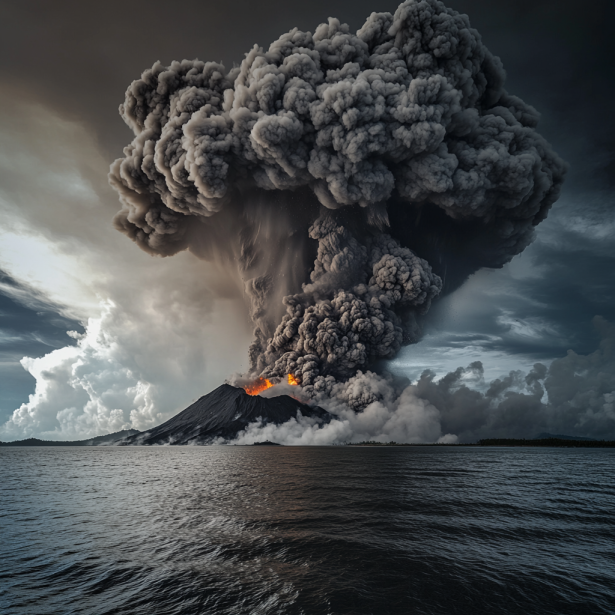Introduction
On August 27, 1883, the island of Krakatoa in Indonesia experienced one of the most catastrophic volcanic eruptions in recorded history. The explosion was so powerful that it was heard over 3,000 miles away, with shockwaves traveling around the globe multiple times. The eruption obliterated most of the island, created massive tsunamis, and caused global climate disruptions, leading to vivid sunsets worldwide for years.
This event left an indelible mark on history, influencing everything from art to science. The aftermath of Krakatoa’s eruption serves as a stark reminder of nature’s raw power and its capacity to alter the world in an instant.
The Eruption: A Catastrophic Event
Build-Up to the Eruption
- Early Signs: Krakatoa had been showing signs of increased volcanic activity in the months leading up to the eruption, with steam and ash venting from the island.
- Initial Explosions: On August 26, 1883, a series of powerful explosions began, culminating in the cataclysmic eruption the following day.
The Main Explosion
- August 27, 1883: The final, colossal explosion occurred at 10:02 AM local time, releasing an estimated 200 megatons of TNT equivalent energy. This explosion was one of the loudest sounds in recorded history, heard as far away as Australia and the island of Rodrigues near Mauritius.
- Island Destruction: The eruption obliterated more than two-thirds of the island of Krakatoa, reducing it to rubble and creating a massive caldera beneath the ocean.
Immediate Aftermath
Tsunamis and Destruction
- Massive Tsunamis: The eruption generated massive tsunamis, some as high as 120 feet, which devastated nearby coastlines. The waves reached as far as South Africa, and an estimated 36,000 people were killed by the tsunamis and pyroclastic flows.
- Regional Impact: Entire coastal villages were wiped out, and the surrounding region experienced significant devastation, with tens of thousands of people losing their homes.
Global Impact
- Shockwaves: The force of the eruption sent shockwaves around the globe multiple times, and barometers worldwide recorded the pressure changes.
- Ash Cloud: The eruption ejected vast quantities of volcanic ash and gases into the atmosphere, which spread globally, causing atmospheric effects that lasted for years.
Long-Term Effects
Climate Disruption
- Global Cooling: The immense amount of sulfur dioxide and ash released into the stratosphere led to a significant global temperature drop of about 1.2 degrees Celsius (2.2 degrees Fahrenheit) for the following years.
- Vivid Sunsets: The particles in the atmosphere scattered sunlight, causing vividly colored sunsets and sunrises worldwide. These effects were noted in art, literature, and scientific observations.
Ecological and Environmental Changes
- Biological Impact: The eruption and subsequent tsunamis caused significant ecological disruption, destroying habitats and altering the local environment.
- Volcanic Winter: The cooling effect and reduced sunlight led to what is often referred to as a “volcanic winter,” affecting agricultural productivity and contributing to food shortages in some regions.
Cultural and Scientific Legacy
Artistic Influence
- Inspiration for Art: The dramatic sunsets caused by the Krakatoa eruption inspired artists worldwide, including painters such as Edvard Munch, whose famous work “The Scream” is believed to be influenced by the eerie red skies resulting from the eruption.
- Literature and Folklore: The event also influenced literature and folklore, with writers and storytellers incorporating the disaster into their works, emphasizing the themes of nature’s power and human vulnerability.
Scientific Advancements
- Volcanology: The Krakatoa eruption marked a significant advancement in the field of volcanology. It led to the first detailed study of a volcanic eruption’s global impact, helping scientists understand the connections between volcanic activity, atmospheric changes, and climate.
- Global Communication: The eruption highlighted the need for better global communication systems, as news of the disaster spread slowly. This event underscored the importance of international scientific collaboration and monitoring systems.
Conclusion
The 1883 eruption of Krakatoa remains one of the most significant and devastating volcanic events in recorded history. Its immediate and long-term effects, from massive tsunamis and global climate disruptions to its impact on art and science, demonstrate the immense power of volcanic forces. The event serves as a reminder of the delicate balance between nature and humanity, as well as the far-reaching consequences of natural disasters. The Krakatoa eruption continues to be studied and remembered as a pivotal moment in the history of both natural science and cultural expression.
FAQs
What was the Krakatoa eruption?
The Krakatoa eruption occurred on August 27, 1883, on the Indonesian island of Krakatoa. It was one of the most violent volcanic events in recorded history, causing massive tsunamis and global climate disruptions.
How powerful was the Krakatoa eruption?
The eruption released energy equivalent to 200 megatons of TNT and was heard over 3,000 miles away. It obliterated most of the island and sent shockwaves around the globe multiple times.
What were the immediate effects of the Krakatoa eruption?
The eruption caused massive tsunamis, killing an estimated 36,000 people, and devastated coastal areas in the region. It also sent vast amounts of ash and gases into the atmosphere, leading to global climate changes.
How did the Krakatoa eruption affect global climate?
The eruption caused global cooling, with temperatures dropping by about 1.2 degrees Celsius for several years. The volcanic ash in the atmosphere also led to vivid sunsets and sunrises worldwide.
What is the legacy of the Krakatoa eruption?
The Krakatoa eruption had a profound impact on art, science, and global communication. It inspired artists, advanced the field of volcanology, and highlighted the need for better international monitoring and communication systems.
Why is the Krakatoa eruption significant today?
The eruption is significant due to its far-reaching effects on climate, culture, and science. It serves as a powerful reminder of the destructive potential of volcanic activity and the importance of studying and understanding natural disasters.

